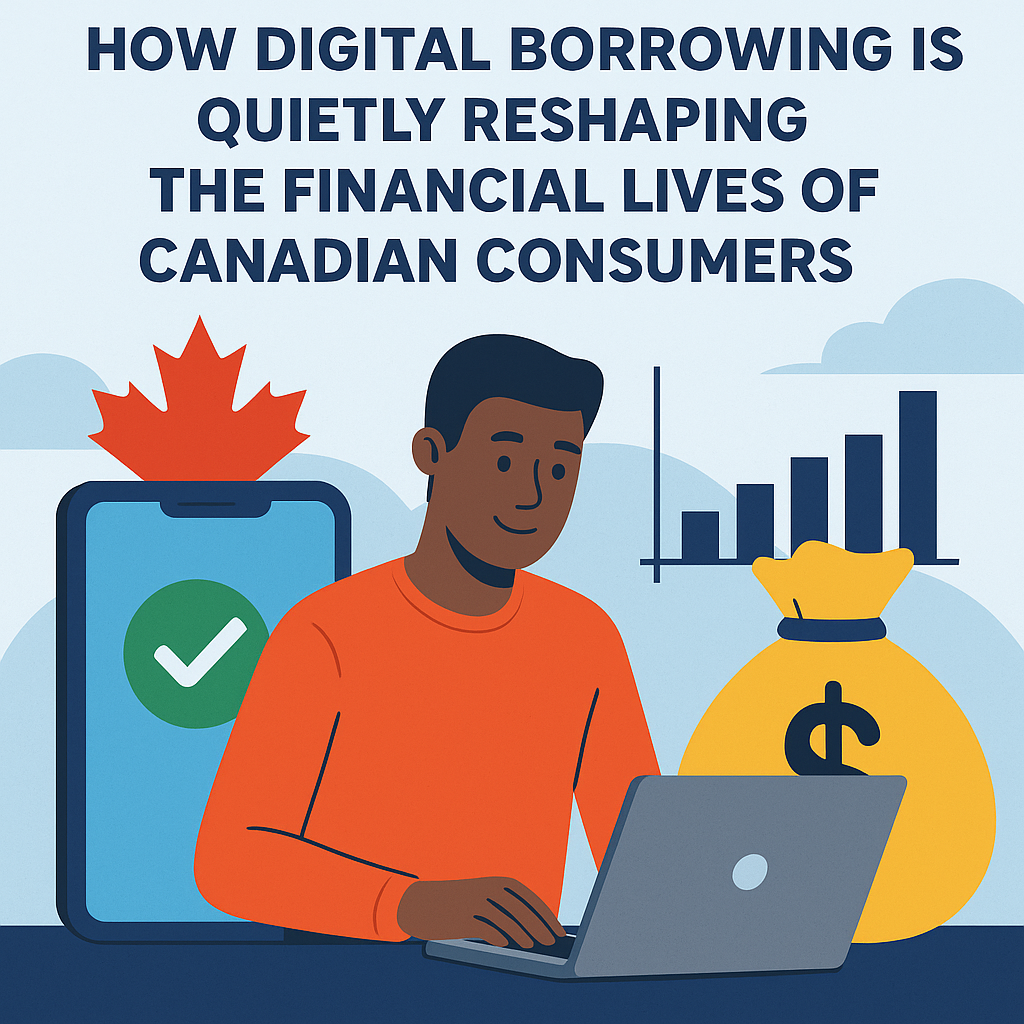Financial behaviour in Canada has always evolved alongside technology, but the pace of change over the past five years has been particularly striking. Many Canadians no longer wait in line at bank branches, collect paper statements, or schedule in person appointments for everyday credit needs. Instead, borrowing has become a digital experience, one that lives mostly on smartphones and laptops. The shift has not been loud or dramatic. It has unfolded quietly, through millions of individual decisions driven by convenience, time pressures, economic realities, and increased access to online financial tools.
This steady move toward digital lending has created new opportunities for Canadians who want faster access to short term funds, clearer loan structures, and more transparent borrowing experiences. It has also challenged lenders who must now balance customer expectations with responsible practices, data security obligations, and evolving regulatory standards. The result is a lending landscape in transition, one that reflects both optimism about financial innovation and caution about how credit should be delivered.
The New Expectations of the Canadian Borrower
The modern borrower looks very different from the borrower of a decade ago. Canadians now manage most aspects of life digitally, whether that means paying bills, transferring money, ordering groceries, or booking professional services. Credit has followed the same path.
Today, many borrowers expect to compare options online, complete applications within minutes, and receive decisions without back and forth correspondence or complex documentation. For people working multiple jobs, supporting families, or living in rural areas, these expectations are not about luxury but about practicality. Time is limited, transportation can be expensive, and financial challenges do not appear on predictable schedules.
Digital lenders who recognise these realities have gained momentum. Platforms such as Canada’s FatCat Loans have expanded by focusing on clarity, turnaround speed, accessibility, and straightforward communication. These lenders understand that people do not want to decode hidden charges, unfamiliar terminology, or uncertain approval timelines. They want certainty and they want honesty, particularly when dealing with personal finances.

Why Convenience Alone Does Not Explain the Shift
It may be tempting to assume digital borrowing has grown simply because it is easier, but convenience is only one part of the story. The growth is also a response to broader financial pressures affecting Canadian households. Inflation, rising interest rates, and increasing living costs have placed strain on budgets across the country. Many Canadians now handle unexpected expenses with greater caution and greater urgency. They want the option to apply for short term financial support quickly if needed, even if they do not always use it.
Another factor is the changing nature of employment. More Canadians now work in flexible, contract based, freelance, or gig economy roles. These income structures do not always align neatly with traditional lending models, which historically favoured borrowers with long term salaried employment. Digital lenders have responded by using updated assessment tools that reflect modern earning patterns.
The Technological Leap Behind Digital Lending
It is easy to focus on the customer facing side of digital borrowing, but the real transformation lies beneath the surface. Automated decisioning, secure identity verification, encrypted document transfer, and structured affordability analysis allow lenders to evaluate risk more consistently and faster than manual review ever could. These systems reduce delays, minimise human error, and create a more predictable borrowing experience.
Artificial intelligence and data modelling have also contributed to this shift. While they do not replace responsible judgement, they help lenders distinguish between applicants who are temporarily short on funds and those who may become financially strained by additional credit. The goal is not to approve more borrowers but to approve the right borrowers for the right product at the right time.
Responsible Innovation and The Importance of Consumer Trust
Trust has become the defining currency of digital lending. Canadians have grown more informed and more cautious about financial institutions, especially in online environments. They research lenders before applying. They read reviews. They compare offerings. They want transparency not just in marketing language but in real world experience.
Digital lenders who prioritise ethical practices continue to earn long term credibility. That means offering clear repayment dates, upfront cost disclosure, accessible customer support, and realistic expectations about borrowing outcomes. It also means acknowledging that credit is not always the best solution and declining applications when necessary. In a responsible framework, saying no can be just as important as saying yes.
Financial Inclusion in a Canadian Context
Canada is often viewed as a financially stable country with broad access to traditional banking, yet many people still remain under served. Remote communities may be far from brick-and-mortar branches. Newcomers may not have long established credit records. Individuals with variable income may struggle to obtain traditional credit products. Digital lending can play a useful role in bridging these gaps when applied thoughtfully.
Accessible online platforms allow Canadians to apply from anywhere with a connection. Straightforward loan structures help people plan more confidently. Educational content empowers borrowers to make informed decisions. More importantly, digital lending gives people the ability to engage with financial systems without barriers related to geography, logistics, or scheduling.
Affordability, Transparency and The Future of Credit Access
Online lending has influenced how Canadians think about loan suitability. Instead of focusing purely on approval odds or monthly instalments, borrowers are increasingly attentive to total borrowing cost, repayment duration, and lender behaviour. This shift has encouraged lenders to simplify product offerings and avoid unclear fee structures. It has also encouraged borrowers to ask better questions and compare alternatives before committing.
For lenders, the future lies in balancing access with protection. Every approved loan should support stability rather than strain. That approach not only safeguards borrowers but also strengthens trust in the digital lending ecosystem.

Regulation and Consumer Protection Remain Central
Canada’s financial regulatory environment plays a significant role in shaping the digital lending sector. Consumer credit laws emphasise affordability assessment, privacy standards, licensing, truthful advertising, and fair treatment. These requirements ensure digital lending does not operate as an unchecked frontier but as part of a monitored, accountable financial system.
Responsible lenders understand that regulation is not an obstacle but a safety net. It creates consistency, enforces boundaries, and protects the long-term health of the market. As digital borrowing continues to expand, regulatory expectations will evolve along with it, supporting innovation while safeguarding Canadians.
Online Borrowing as a Normal Part of Financial Life
The rise of online loans in Canada is not a temporary trend or opportunistic surge. It is an example of how technology can improve access when used responsibly. For many Canadians, it now feels normal to research loan options online, compare lenders, submit documents digitally, and receive decisions without leaving home. That normalisation will continue as digital systems become more intuitive and more integrated into everyday financial routines.
Borrowing will always require thought and responsibility, but the growing expectation is that lenders should contribute to that responsibility rather than shift the burden entirely onto borrowers. Clear language, supportive tools, and honest structures are becoming industry standards.
Looking Forward
Digital borrowing has not replaced traditional lending and likely never will. Instead, it has expanded the ecosystem by offering an alternative for people who value speed, clarity, and accessibility. The most successful lenders in the coming years will be those who refine this model thoughtfully rather than aggressively. They will view borrowers as partners, not statistics, and design products that reflect the realities of life in modern Canada.
As technology advances, Canadians can expect lending experiences that are even more streamlined, transparent, and tailored. The key is ensuring that innovation continues to serve people rather than the other way around.














